B of I V.R.

Beez Neez now Chy Whella
Big Bear and Pepe Millard
Fri 20 Dec 2013 23:07
|
The Bay of Islands Vintage
Railway

 Twenty minutes after leaving Opua in
our ‘Rent a Dent’, I asked Bear to turn right at a sign I had seen for the
Kawakawa Railway, five minutes later we were sitting waiting
for the train to pull out, listening to Denis
give us the history of the line. Chance is a wonderful thing.
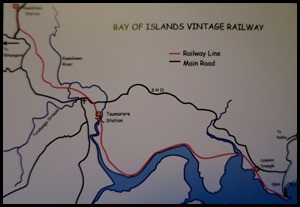 Prior to the arrival of the
Europeans, the Taumarere area was an area of major importance to Māori both for
food and strategically, and there had been a substantial Māori Pa locally. There
were also very strong links between the East and West coasts and an often quoted
Maori saying is as follows:
Ka toto te puna i Taumarere, ka
mimiti te puna i Hokianga.
Ka mimiti te puna i Taumarere, ka
toto te puna i Hokianga.
When the spring at Taumarere bubbles
over, the spring at Hokianga ebbs.
When the spring at Taumarere ebbs,
the spring at Hokianga bubbles over. – What affects the tribe at Taumarere also
affects the tribe at Hokianga.
So it is understandable that
Taumarere, at the head of navigable tidal water on the river, was settled before
Kawakawa as it was a natural landing place. Further down the river the British
had landed before heading inland to fight at Ruapekapeka. Had it not been for
the discovery of coal at kawakawa, Taumarere would probably have been developed
into a premier town in the area.
 The first railway
engine in the North Island pulled coal from Kawakawa to the Derrick
Landing at Taumere.
Taumarere came into its own when coal
was discovered at Kawakawa in 1864. The obvious way to get the coal to the sea
was to transport it down the Kawakawa River, and so in 1867 a wooden tramway was
built and the coal was hauled down, first by horses and then in railway wagons
to be loaded into barges at “the Derrick”. The barges were then pulled
downstream by the two local steamers, Ida and Black Diamond, to the Loading
Ground at the junction of the Kawakawa and Waikare Rivers, to the ships at
Opua.
  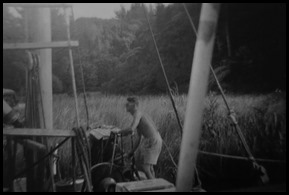 Alan
Larcombe loading sand onto Charlie Timperley’s truck at the Derrick.
Fred Sherwin at the Derrick Landing cargo shed (circa
1934). Charlie Demply at the Derrick.
In 1878 increased demand for Kawakawa
coal meant that a new derrick had to be built in place of the original. The
local newspaper, “The Northern Luminary” explained how the coal was loaded: “The
company’s large barges, some of them carrying 120 tons, are loaded by means of a
powerful crane which lifts the coal boxes off the wooden frames and swings them
over the barges. At the bottom of each box there is a contrivance for keeping it
fast, and as soon as the box is in position a catch is struck and the door opens
letting the coal fall into the barge. It is a very expeditious way of working.”
Although the river has altered course, some piles of the old derrick can still
be seen near the long bridge.


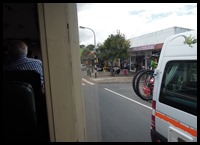
 It was quite something to be going
down the centre of the High Street. The only rail in
New Zealand to do so.
 We were soon (looking out to the left)
looking out into the lush, green countryside.
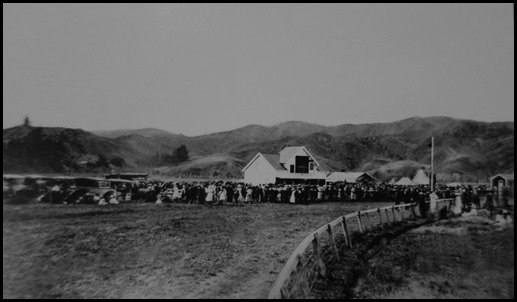 Race meeting at
Taumarere (circa 1920)
Denis explained that where we were
looking used to be the site of a race course. Popular
race meetings were held on the Public Recreation Ground on the other side of the
Kawakawa River and just north of the junction with the Tirohanga River. This was
a source of some jealousy for the people of Kawakawa who initially did not
have such a facility. For much of the year the Recreation Ground was leased to
Hemi Tautari who used to graze his cattle, but on race days it was awash with
excitement and colour. The Exchange was conveniently located close to the race
course and on race days would put on a wonderful “Cold Coalition” of roast
turkey, geese and duck, with ham, corned beef, tongue, salad pastry and cheese
for a shilling and six pence. Tea or coffee extra. In the evening there would be
a Grand Entertainment in the Public Hall with songs such as “Sweet face at
the window” and “See that my grave’s kept clean”. Denis told us to
keep a good look out the right side for the famous Lava
Tree..........
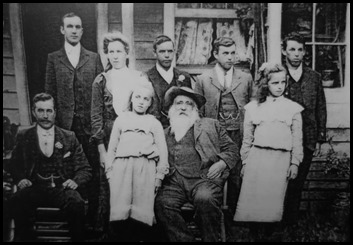  Charles
Goodhue (bearded) with part of the family. From leftback Louis, Elizabeth
(Bessie), Gilbert (Gillie), Fred, Clarence. Front, Herbert (Bert), May, Estella
(Stella) pictured approx 1903.
Charles (originally from America) and
Elizabeth Goodhue built their home in 1872 about a hundred yards from the St
Andrew Church site and established the Goodhue Nursery. The nursery rapidly
became a major producer of grape vines and a wide range of fruit trees and
ornamentals, as well as vegetables which were widely distributed around the
district, to Auckland and even overseas. The trees were individually packed,
their roots in sawdust in small hessian bags each individually hand sewn by
Elizabeth. In 1904 a major flood roared through Taumarere and destroyed the
orchard. A dinghy was found lodged in the top of a peach tree. In 1909, their
son Charlie and his wife Lizzie built a house adjoining their parents and
re-established the orchard and thriving business. In January 1989 a reunion was
held at the Rugby Club, part of which was the re-sited Soldiers Memorial Hall.
There are three houses still in use in Taumarere which were once owned by the
family.
  The Soldiers
Memorial Hall, original and The United Kawakawa Rugby
Club.
On June the 23rd 1921, a group of
local people met in the Pakaru School to set up a new building as a memorial to
the men of the district who fell in World War I, and for the community. The
original Management Committee comprised JJ Ware, H Doel, HL Irving, J Doel jnr.,
CS Goodhue, E Doel and G Simpson and the land was donated by Bert Goodhue. The
site was on the right-hand side of Waikare Road, just up from the corner with
the main road. A piano was purchased for forty two pounds, twelve shillings and
sixpence, delivered by the scow Alma in 1923. Money for the hall was
raised by subscription, dances and a range of other activities and the new hall
was opened with a memorial service on Sunday the 20th of August 1923, with an
opening dance held on the 30th. Door charges for Gents – three shillings, Ladies
– two shillings and the Refreshment Committee – free.
The hall had an excellent wooden
dance floor and it is noted in the Minutes 1/5/1924 “That the White boys of
Taumarere be allowed the use of the hall for boxing practice subject to having
the floor well sawdusted, no nailed boots to be worn and to repair breakages and
find own lights”.
The hall was well used and income
seems to have come from lantern slide evenings, concerts, socials, bridge
evenings, boxing, dancing classes and table tennis, together with use by such
groups as the Taumarere Country Womens Institute.
By 1968 the CWI were the only hall
users and major renovations were necessary, particularly for the kitchen
although the dance floor and the building itself were still in very good
condition. So after many years of struggle and discussion and offers to remove
it, it was offered to the United Kawakawa Rugby Club to add to their existing
clubrooms on condition it remained a Soldiers Memorial Hall and available for
use by local people. The hall was shifted to its present site in 1979 and the
site sold back to Earl Goodhue, one of Bert Goodhue’s descendants. A plaque
commemorating the shift was donated by Selwyn and Joan Wilson.
 
 Ruby
stopped and was moved across the track to the other end of
the carriage. Denis led us out to Bridge
Nine.
 Bridge Nine in
action.
  Bridge Nine straddles the Kawakawa
River for a distance of seven hundred feet and is supported by thirty five piers
each with four piles. The current bridge is the third to cross the river at this
point. The first was built in 1881 but was washed away, replaced in the
1910-1915 era and may have been longer than the present one. The bridge before
us was built in the late 1940’s early 1950’s and is considered to be the longest
curved wooden bridge left in the Southern Hemisphere and possibly one of the few
left in the world which is still being used, sadly, not at the moment. Work is
due to begin in February, replacing rotten timbers with pine. The cost is being
shared with the Tourist Commission who is widening the sides, replacing and
making higher the side fencing to allow cyclists to use the bridge.
  Track Gang (circa 1910). Bridge Gang
with Family.
In the old days all the
work on the original track was done by hand – pick, shovel, crowbar and
wheelbarrow. The original sleepers were all Australian hardwood, of which there
were seven varieties, and the rails were fixed with dog spikes. The original
rails were fifty six pounds to the yard weight, later changed to seventy two
pounds to the yard. Of interest is the two hundred and fifty foot long tunnel,
some couple of miles further on from the Long Bridge. This was dug by hand, and
lined with bricks that were dug from clay that was adjacent to the tunnel.
Today, the hand tools have been replaced by machinery, the sleepers are treated
pine, the rails are ninety one pounds to the yard and the dog spikes have been
replaced by screws.
 
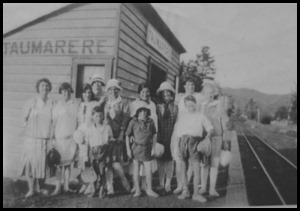 Bear couldn’t resist playing with the big boy
toy and then we all stood in the station to
learn more about the area. The little station building was originally located between Bridge Five and the Rugby Club
area. In addition to the station there was a water tower, cattle loading
facilities and a passing loop. In its hey day this was a bustling area with coal
wagons coming and going to Derrick Landing. With the decline of coal the station
building deteriorated until in 1963 Alex Lemon decided the kauri-planked
building was too good to waste so he bought it for a hundred pounds and it was
trucked to his farm in Whangae by Jack Jellick Transport, where it was used as a
storage shed. Then, in 1997 his son Ray, who bought the farm from his father,
donated it back to the Railway and it was moved initially to Kawakawa on a flat
wagon to be scrubbed and painted. A few weeks later there was a great day when
TV star April Iremiea and “April’s Angels” came to Kawakawa, the station was
taken to its current location by the Long Bridge and placed in position, the
platform upgraded, and the site developed in front of the TV cameras.
The site was used as a
special BBQ stop-over. The train would stop en route to Opua, the food and cooks
off-loaded, and then when the train returned from Opua the food was ready, the
lights in the trees all twinkling and a great festive atmosphere
created.
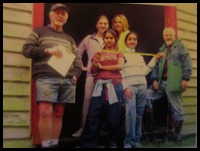  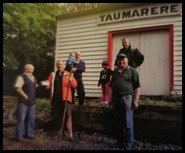 The closure of the
railway in 2000, the building and its surroundings deteriorated, graffiti daubed
and generally unkempt. That was until Frank Leadley worked with a group of girls
from Springbank School to upgrade the building in Enterprise Education. The
girls – Jessica, Fiona, Priyanka, Jasmine and their
teacher Michelle, did an outstanding job, clearing the site, obtaining
materials, cleaning and painting. Dennis Hewitt with
Community Max workers put in the new platform and Max
Huxford presents a cheque to Frank Leadley. All finished in mid 2009.
   Volunteers worked hard, half way
mark and arriving for work.
Taumarere was for a while the largest
town in the Bay of Islands. Today, just a few scattered houses and the Church of
St Andrew is all that is left of the once bustling settlement of two thousand
people (at its height). Local Māori built a flour mill near Derrick Landing,
described in the Weekly News as follows: “The building is a neat little
three-storied structure of wood. The driving power is given by a 10hp horizontal
engine. The first floor is used for a bagging and store room. The machinery here
consists of smutters and elevators. The second storey contains a pair of
mill-stones, a silk-dressing machine etc. The upper storey holds the hoppers and
is used as a grain store.”
The mill was working in 1875 and the
local Māori grew wheat, but heavy rain one year ruined the crop and they leased
the building to a William Callaghan who established a bakery business at
Taumarere. Later leases saw the mill used as a general store and, in 1882, for
the manufacture of soda water and cordials by the Triphook family. The mill was
eventually pulled down for removal, probably around 1886.
The Public Hall was on the corner
just past the church, and was opened in 1876. It was “a neat and compact
building of wood, well fitted by a handsome chandelier, and capable of
accommodating 300 people.” (Weekly News dated the 8th of April 1876). Maihi
Paraone Kawiti convened an open meeting to explain that the hall was erected by
the Māori's with Government financial help and was to be a place of assemblage
for the chiefs of Ngapuhi, for the furtherance of charitable objects, and as a
courthouse. People from Kawakawa had come to the courthouse by train, as it was
some time before the mining town had its own Magistrate’s court.
 Taumarere
School, about 1884 (The teachers from the left – Mrs Tautari, Miss
Johnson, Miss Bryers and Miss Nielson.
Hemi (James) Tautari was an old “sea
salt” who lived beside the railway line almost opposite the Church of St Andrew.
By 1870 he had retired from the sea and had set up a large store at Taumarere
and carried on”extensive transactions in land.” He died in 1883 but his second
wife, Mary, who had “the character of a very shrewd woman” worked very hard to
improve the lot of local Māori, and she established a boarding school for Māori
girls (and, at a later stage some Māori and European boys who attended as day
pupils). This was alongside their home, which was close to the Bray homestead
which still exists. The school opened in the late 1860’s or early 1870’s and was
under the patronage of Sir George Grey the Governor. Originally the purpose of
the school was for selected Māori girls to be taught the social graces of the
English aristocracy so that they could act as hostesses to the wives of British
officers in the area. The school was evidently run very well, and there were
many complimentary comments, including in 1876 from the Governor, who commented
on the children’s neat and tidy appearance, their orderly precision, their
creditable writing, their singing of “I hear thee speak of a better
land” in good time and voice, and the creditable condition of the school. A
written comment on the school contains “In point of discipline Mrs Tautari
is necessarily strict, but she is loved by all the children on account of her
kind and amiable disposition” and “At Mrs Tautari’s establishment they
are instructed in household duties in order that they may be Europeanised as
much as possible..... Children are sent to the Taumarere school from very long
distances on account of the high reputation it enjoys”.
  The church when it was St. Paul’s in Paihia (1902) and today as St. Andrew’s
The historic church of St Andrew has
its roots back in the early missionary days in Paihia. The first church was
built at Paihia was a raupo building, followed bin 1823 by a church established
by the Rev. Henry Williams and formally dedicated as the Church of St Paul. This
was followed by a lathe and plaster church building in 1828 and then a wooden
church in 1856.
The church of St Andrew began its
life when some of its timbers were used to build that first wooden church of St
Paul in 1856, replacing the original lath and plaster building. In 1874 this
second St Pauls was replaced by another wooden church, later to become St
Andrews, and again incorporating some of the timbers and even the plan from the
1856 building. The cost of this building was four hundred and fifty five pounds,
which included the organ.....
The church was built mainly to serve
a Māori population with a Māori clergyman and continued for fifty years. But the
church went into a period of decline and the building fell into disrepair until
it was rebuilt and upgraded by William Henry Bedgood from Waimate in the period
1904/05
But then in 1924 the descendants of
Henry and William Williams decided to commemorate the work of the missionary
brothers by erecting a memorial stone church on the site, to be known as
Williams Memorial Church. And so in 1925 the old 1874 wooden building was
dismantled, and was barged in sections via the Veronica Channel and Kawakawa
River to the Tirohanga riverbank and then sledged by bullock team to its present
position on the slight rise beside the main highway. It was certainly lovely to
learn about some of the social history of the area.
 On our return journey, we did indeed
see the Lava Tree, now we had a full explanation. The
brown one at the top is called Chocolate Blancmange, for no really good reason.
Directly below is Picasso. To Picassos left is Gone Fishin’. Below that with the
wig is Party Girl. Top right is obviously the All Blacks. The black and white
one below is named for the RWC – The Rugby World Cup. Bottom right is Royal
Flush. Up near the house Pooh Bear sits on his own throne and we cannot think of
a single comment on this one.................................
 
 Over the last
bridge and back to the station for a closer look at Ruby. She was put away and Freddie came out to take her place. Time for a look
around.
 
 Away in the shed is a steam train, currently under tender loving care. The water tower and a little
chap.
 
 In our carriage we had
seen a plaque and a picture
of Frederick Hundertwasser (Denis says we must
walk down the High Street to visit the toilets named after him........), at the
end of the platform was La Giudecca, his
boat.
 The turntable and then we looked at some old pictures in the waiting
room.

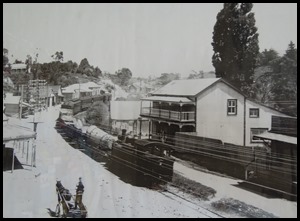

ALL IN ALL CHANCE IS A
WONDERFUL THING
FABULOUS OFF PISTE
EXPERIENCE
|